Influence of bimodal non-basal texture on microstructure characteristics,texture evolution and deformation mechanisms of AZ31 magnesium alloy sheet rolled at liquid-nitrogen temperature
Shouzuo Zhng ,Li Hu,* ,Yuto Run ,To Zhou ,Qing Chen ,Yng Zhong ,Lixin Shi,Mingo Li,Mingbo Yng,Shuyong Jing
aCollege of Material Science and Engineering,Chongqing University of Technology,Chongqing 400054,China
b Southwest Technology and Engineering Research Institute,Chongqing 400039,China
c School of Advanced Manufacturing Technologies,Tomsk Polytechnic University,Tomsk 634050,Russia
d College of Material Science and Engineering,Taiyuan University of Technology,Taiyuan 030024,China
Abstract Cryogenic rolling experiments have been conducted on the AZ31 magnesium (Mg) alloy sheet with bimodal non-basal texture,which is fabricated via the newly developed equal channel angular rolling and continuous bending process with subsequent annealing (ECAR-CB-A)process.Results demonstrate that this sheet shows no edge cracks until the accumulated thickness reduction reaches about 18.5%,which is about 105.6% larger than that of the sheet with traditional basal texture.Characterization experiments including optical microstructure (OM),X-ray diffractometer (XRD),and electron backscatter diffraction (EBSD) measurements are then performed to explore the microstructure characteristics,texture evolution and deformation mechanisms during cryogenic rolling.Experimental observations confirm the occurrence of abundant {10–12} extension twins (ETs),twin-twin interactions among {10–12} ET variants and {10–12}-{10–12} double twins (DTs).The twinning behaviors as for {10–12} ETs are responsible for the concentration of c-axes of grains towards normal direction (ND) and the formation of transverse direction (TD)-component texture at the beginning of cryogenic rolling.The twinning behaviors with respect to{10–12}-{10–12} DTs are responsible for the disappearance of TD-component texture at the later stage of cryogenic rolling.The involved deformation mechanisms can be summarized as follows: Firstly {10–12} ETs dominate the plastic deformation.Subsequently,dislocation slip,especially basal slip,starts to sustain more plastic strain,while {10–12} ETs occur more frequently and enlarge continuously,resulting in the formation of twin-twin interaction among {10–12} ET variants.With the increasing rolling passes,{10–12}-{10–12} DTs incorporate in the plastic deformation and dislocation slip serves as the major one to sustain plastic strain.The activities of basal slip,{10–12} ETs and {10–12}-{10–12} DTs benefit in accommodating the plastic strain in sheet thickness,which contributes to the improved rolling formability in AZ31 Mg alloy sheet with bimodal non-basal texture during cryogenic rolling.
Keywords: AZ31 Mg alloy;Bimodal non-basal texture;Cryogenic rolling;Microstructure evolution;Deformation mechanism.
1.Introduction
Due to their excellent physical and mechanical properties including low density,high specific strength and stiffness,remarkable damping performance and so on,wrought magnesium (Mg) alloys have been termed as potential candidates in the field of aerospace,electronic 3C,automobile industries[1–4].Among all processing technologies of wrought Mg alloys,hot rolling serves as an important continuous forming technology for manufacturing sheet products.Nowadays,numerous investigations have been conducted to optimize the hot rolling process,investigate the microstructure characteristics,and shed a light on the corresponding deformation mechanisms of wrought Mg alloys.Take the most widely used AZ31 Mg alloy for example,Tighiouaret et al [5].reported that the average grain size of AZ31 Mg alloy sheet can be refined from 16 μm to 7.9 μm after a medium strain hot rolling (the accumulated thickness reduction of 50%) and to 4 μm after a high strain hot rolling(the accumulated thickness reduction of 85%) at 623 K.The grain refinement results in the improvement of hardness of fabricated sheet from 72.5 Hv to 79.5 Hv and 86.1 Hv,respectively.Guo et al [6].successfully realized a 50%thickness reduction in AZ31 Mg alloy sheet after a single pass of hot rolling at 798 K.They reported the existence of abundant shear bands,which can coordinate plastic deformation between neighboring grains and delay the occurrence of cracking during a large strain hot rolling.Moreover,Wang et al [7].studied the influence of texture type on deformation mechanisms of AZ31 Mg alloy sheet after 10%–50% thickness reduction during hot rolling at 573 K.They confirmed that dislocation slip is the main deformation mechanism for sheet with basal texture,while for sheet with prismatic texture,{10–12} extension twin (ET) serves as the dominant deformation mechanism.
Besides the traditional hot rolling process,rolling under cryogenic environment(liquid-nitrogen temperature,77 K),as a relatively novel process,has currently attracted more and more attentions due to its huge potential in tailoring grain size and improving strength property of metallic materials[8–10].As for AZ31 Mg alloy,Luo et al [11].reported that the yield strength of AZ31 Mg alloy sheet can be significantly enhanced from 150 MPa to 250 MPa after cryogenic rolling at the accumulated thickness reduction of 8%.Moreover,they found that the inhibition of dislocation slip during rolling at liquid-nitrogen temperature contributes to the occurrence of a large amount of twins.Lee et al [12].reported that the annealing treatment on AZ31 Mg alloy sample rolled at liquid-nitrogen temperature would lead to the occurrence of an obvious bimodal microstructure,which consists of fine recrystallized grains and coarse un-recrystallized grains.They confirmed that this observed microstructure is closely related to the localized recrystallization behaviors in these highly twinned regions.However,the abovementioned investigations are mainly limited to AZ31 Mg alloy sheet with typical basal texture,investigations on the cryogenic rolling behavior of AZ31 Mg alloy sheet with non-basal texture have been rarely reported.
The present study focuses on investigating the influence of non-basal texture on rolling behavior,microstructure characteristics and texture evolution of AZ31 Mg alloy sheet at liquid-nitrogen temperature.The chosen AZ31 Mg alloy sheet is prepared by the newly developed technology of equal channel angular rolling and continuous bending process with subsequent annealing (ECAR-CB-A) [13].This fabricated sheet possesses a rare bimodal non-basal texture,where c-axes of most of grains tilt about ±40° away from normal direction(ND) to rolling direction (RD).Song et al [14].reported that AZ31 Mg alloy sheet with this bimodal non-basal texture possesses an average Erichsen value of 7.4 mm,which is much higher than that of 4.6 mm in AZ31 Mg alloy sheet with the typical basal texture.This issue demonstrates that this bimodal non-basal texture contributes to improving the stretch formability of AZ31 Mg alloy sheet at room temperature and broadening the corresponding engineering applications.Cryogenic rolling experiments are then conducted and the evolution of microstructure and texture of these rolled samples are characterized and analyzed by means of optical microstructure(OM),X-ray diffractometer (XRD),and electron backscatter diffraction (EBSD) measurements.
2.Material and methods
The as-received AZ31 Mg alloy sheets with the thickness of 1.1 mm were manufactured by the ECAR-CB-A process.The specific die structure and processing parameters about ECAR-CB-A process have been well documented in the literature[15].Moreover,AZ31 Mg alloy sheets with the typical basal texture were served as control group and they were fabricated by the conventional hot rolling process to the thickness of 1.1 mm.Before cryogenic rolling experiment,strip specimens with 60 mm (RD) × 40 mm (transverse direction,TD) were cut by using electro-discharge machining (EDM).These strip specimens were then placed in a vessel filled with liquid nitrogen for 10 min in order to achieve an uniform temperature distribution.Once these strip samples were removed from the vessel,multi-pass cryogenic rolling experiments were immediately conducted.Considering the poor rolling performance of AZ31 Mg alloy sheet at liquid-nitrogen temperature,which is reported by Luo et al [16].,a relatively small thickness reduction per pass of 5% is chosen in the present study.To avoid the temperature effect on rolling behavior,these rolled samples were immersed within the liquid nitrogen environment for 10 min between each pass.Moreover,the diameter of the applied roller was 170 mm and the corresponding roll speed was 400 mm/s.
OM observation was carried out by using a Leica DMI5000M metallographic microscope.After mechanical grinding with #400,#800,#1200 and # 2000 SiC papers,these un-rolled and rolled samples were etched in a picric acetic solution (5 g picric acid+70 mL ethanol+10 mL glacial acetic acid +10 mL water) until the solution turns red.To measure the evolution of dislocation density in AZ31 Mg alloy sheet with bimodal non-basal texture during cryogenic rolling,XRD measurement was further performed on the ND planes of un-rolled and rolled samples by using a Rigaku D/Max 2500 PC.The specific characteristics about microstructure and texture were measured and analyzed via a FEI NOVA 400 Zeiss Sigma field emission scanning electron microscope equipped an HKL-Nordlys MAX detector.Samples for EBSD measurement were prepared by mechanical grinding firstly,followed by electrochemical polishing in ACII electrolyte at 233 K for 210 s at 0.02–0.03 A/20–30 V.A small step size of 2 μm was applied in the present study in order to confirm a good indexing rate during EBSD measurement.These obtained EBSD data were thereafter processed by using the Channel 5 analysis software and MTEX toolbox.
3.Results
3.1.Initial microstructure and texture
Fig.1 shows the initial microstructure and texture of AZ31 Mg alloy sheets manufactured by the ECAR-CB-A process and the hot rolling process.The OM images in Fig.1(a) and(f) illustrates that these equiaxed grains are homogeneously distributed within these fabricated sheets,indicating the occurrence of complete recrystallization.The correspondingly statistical analysis of grain size on TD,RD and ND planes are displayed in Fig.1(b–d) and (g–i),respectively.The measured average grain size is in the range of 32 μm to 36 μm for sheets fabricated by the ECAR-CB-A process and the hot rolling process.Therefore,the effect of grain size on the rolling performance at liquid-nitrogen temperature can be excluded here.It is interesting to note that the average grain size of sheet manufactured by the ECAR-CB-A process is quite larger than that of about 15 μm reported in the work of Chen et al [13].The reason resulting in this huge difference about grain size is that the applied annealing treatment is 773 K/ 12 h in the present study,whereas the applied annealing treatment is 573 K/ 1 h in the work of Chen et al[13].Fig.1.(e) shows that the adopted annealing treatment in the present study does not change the texture characteristics of bimodal non-basal texture,where c-axes of most of grains tilt about ±40° away from ND to RD in the (0002)pole figure(PF)map with the maximum intensity of 2.7 times random.By comparison,the AZ31 Mg alloy sheet fabricated by the hot rolling process possesses a strong basal texture with the maximum intensity of 8.8 times random,as shown in Fig.1(j).
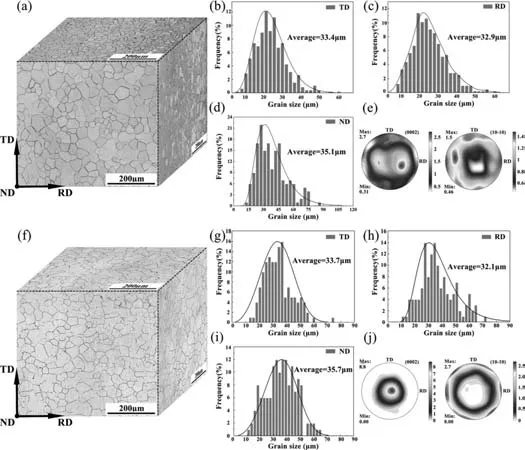
Fig.1.Initial microstructure and texture of AZ31 Mg alloy sheets fabricated by the ECAR-CB-A process and the hot rolling process: (a) and (f) OM images on three mutually perpendicular planes;(b–d) and (g–i) The corresponding distribution of grain size on TD,RD and ND planes;(e) and (j)(0002) and (10–10) PF maps.
3.2.Cryogenic rolling formability
Fig.2(a) presents the macroscopic picture of AZ31 Mg alloy sheet with bimodal non-basal texture during cryogenic rolling,where the edge cracks are highlighted by a red dotted ellipse in the enlarged image.Observation shows that no edge crack occurs on the rolled sheet until the accumulated thickness reduction reaches about 18.5% after the fourth pass of cryogenic rolling.As for the AZ31 Mg alloy sheet with initial basal texture,Fig.2(b) shows that edge crack occurs after only two passes of cryogenic rolling and the correspondingly accumulated thickness reduction is about 9.0%.This is quite similar to the cryogenic rolling formability of AZ31 Mg alloy sheet with basal texture,as reported by Luo et al [16].Meanwhile,they claimed that strain concentration would be responsible for the occurrence of edge crack Fig.2.(c) intuitively displays the huge difference about the cryogenic rolling formability of these two AZ31 Mg alloy sheets.Actually,the accumulated thickness reduction of AZ31 Mg alloy sheet with bimodal non-basal texture during cryogenic rolling is about 105.6% higher than that of AZ31 Mg alloy sheet with basal texture.This indicates that the bimodal non-basal texture has great influence on the cryogenic rolling formability of AZ31 Mg alloy sheet.

Fig.2.Cryogenic rolling formability of AZ31 Mg alloy sheets: (a) Macroscopic photographs of rolled sheets with initial bimodal non-basal texture;(b) Macroscopic photographs of rolled sheets with initial basal texture;(c)Comparison of the accumulated thickness reduction of two kinds of AZ31 Mg alloy sheets during cryogenic rolling.
3.3.Microstructure evolution during cryogenic rolling
Fig.3 shows the OM observations on the RD × TD surfaces of rolled sheets during cryogenic rolling.As for these two AZ31 Mg alloy sheets,these parallel deformation twins with lenticular morphology occur within some grains after the first pass of cryogenic rolling,as shown in Fig.3(a) and(e).However,the density and volume fraction of deformation twins in AZ31 Mg alloy sheet with bimodal non-basal texture is obviously higher than those in AZ31 Mg alloy sheet with basal texture.The type of deformation twin is considered to be {10–12} ET,as reported by Lee et al [17].and Zhang et al[18].After the second pass of cryogenic rolling,these {10–12} ETs occur in more grains and the thickness of {10–12}ET becomes thicker,as shown in Fig.3(b) and (f).Moreover,{10–12} ETs begin to intersect with each other.With the increasing rolling passes,the number of {10–12} ETs further increases and the phenomenon of twin-twin interaction becomes more obvious in AZ31 Mg alloy sheet with bimodal non-basal texture,as shown in Fig.3(c) and (d).
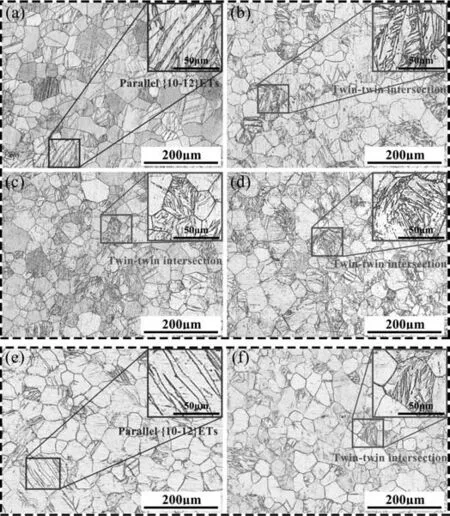
Fig.3.OM images showing the microstructure evolution during cryogenic rolling in AZ31 Mg alloy sheets with bimodal non-basal texture (a–d) and basal texture(e,f):(a)and(e)After the first pass;(b)and(f)After the second pass;(c) After the third pass;(d) After the fourth pass.(The inserted blue rectangle is magnified to show these parallel {10–12} ETs and the inserted red rectangle is magnified to show these twin-twin intersections).
It is worth noting that except for {10–12} ETs,there may exist other types of deformation twins in these rolled sheets with initial bimodal non-basal texture.To verify this issue,these specific microstructure characteristics are further investigated and analyzed by EBSD measurements on the RD × TD surfaces in Fig.4.These commonly reported deformation twins in Mg alloys including {10–12} ET,{10–11} compression twin (CT) and {10–11}-{10–12} double twin (DT)are identified in the present study.These twin boundaries are highlighted by red,green and blue lines,respectively.As shown in the inverse pole figure (IPF) maps (Fig.4(a1)–(d1))and grain boundaries (GB) maps (Fig.4(a2)–(d2)),{10–12}ETs dominate the microstructure of rolled sheets with initial bimodal non-basal texture,whereas {10–11} CTs and {10–11}-{10–12} DTs can seldom be observed even after three or four passes of cryogenic rolling.Moreover,the statistical result about the fraction of {10–12} ET boundaries decreases gradually(~22.9%,~11.7%and~8.2%after the first,second and fourth pass of cryogenic rolling).Similarly,these rolled samples with initial basal texture also possess a decreasing tendency about the fraction of {10–12} ET boundaries(~1.79% and~1.37% after the first and second pass of cryogenic rolling),as shown in supplementary materials (SFig.1).This decreasing tendency about{10–12}ET boundary proportion indicates that with the progression of plastic deformation,these matrix grains would be gradually consumed by {10–12} ETs.Moreover,twin-twin interactions between various{10–12} ET variants occur more frequently along with the increasing rolling passes.Nave et al [19].reported that {10–12} ET variants generated on any one of six {10–12} planes would hinder the migration of one another in a grain,leading to the formation of three types of twin boundaries,including (10–12)-(01–12),(10–12)-(-1012) and (10–12)-(0–112).These twin boundaries are highlighted by yellow,sky blue and pink lines,respectively,and the corresponding misorientations can be illustrated by 60.0°<10–10>,7.4°<1–210>and 60.4°<8–1–70>,respectively.Obviously,EBSD observations confirm that the (10–12)-(01–12) twin-twin interaction dominates the relationship between various {10–12} ET variants during cryogenic rolling of AZ31 Mg alloy sheet with bimodal non-basal texture.The aforementioned observations are further validated via the statistical analysis about misorientation angle in Fig.5,where peaks at~38° around the<11–20>axis,~60° around the<10–10>axis,and~86°around the<11–20>axis correspond to {10–11} CT,(10–12)-(01–12) twin-twin interaction and {10–12} ET,respectively [20].Moreover,peak at 83–89° decreases obviously with the increasing rolling passes,indicating the weakened activity of {10–12} ET during cryogenic rolling of the applied AZ31 Mg alloy sheet with bimodal non-basal texture.
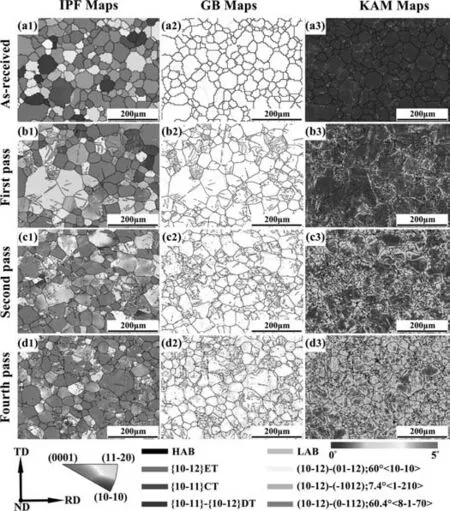
Fig.4.EBSD analysis of microstructure characteristics in rolled samples with initial bimodal non-basal texture: (a1)–(d1) IPF maps;(a2)–(d2) GB maps;(a3)–(d3) KAM maps.
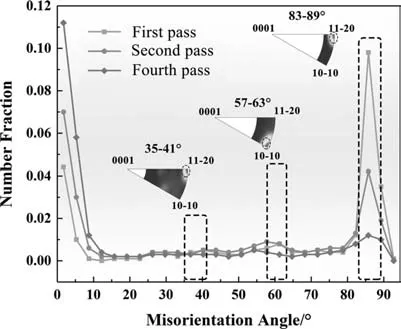
Fig.5.Statistical analysis about misorientation angle in rolled sheets with initial bimodal non-basal texture during cryogenic rolling.
Fig.4(a3)–(d3) displays the kernel average misorientation (KAM) maps of rolled sheets with initial bimodal nonbasal texture during cryogenic rolling.In general,KAM value can be calculated using the average misorientation between a given pixel and its nearest neighbors within the same grain,and it serves as an indirect indicator of dislocation density during plastic deformation of metallic materials [21].Obviously,high KAM values could be observed,especially around regions including grain boundaries,{10–12} ETs and (10–12)-(01–12) twin-twin interactions.This issue demonstrates that a large amount of dislocation is hindered and accumulated in these areas.Besides,the average KAM value in the present study gradually increases from 0.84° after the first pass to 1.35° after the second pass and 2.09° after the fourth pass.This phenomenon agrees well with the evolution of the low angle boundaries (LABs) shown in Fig.4(a2)–(d2).LABs,highlighted by grey lines,refer to boundaries whose misorientation ranges from 2° to 15°.Generally,the relative content of LABs closely relates to the dislocation density,namely the larger the relative content of LABs,the larger the dislocation density would be [22].Obviously,there exists only a relatively small increase about the relative content of LABs during the beginning two passes of cryogenic rolling.This issue indicates that only a small amount of dislocation is involved in the plastic deformation.However,with the increasing rolling passes the relative content of LABs increases significantly.This issue is mainly ascribed to the fact that the liquid-nitrogen temperature could inhibit the occurrence of dynamic recovery during plastic deformation of metallic materials,and therefore benefit in the accumulation of dislocation to sustain plastic strain [23].
3.4.Texture evolution during cryogenic rolling
The (0002),(10–10) and (10–12) PF maps of rolled AZ31 Mg alloy sheets with initial bimodal non-basal texture are depicted in Fig.6.Obviously,the as-received sheet possesses a bimodal non-basal texture where the basal poles tilt about ±40° away from ND to RD,as displayed in Fig.6(a).After the first pass of cryogenic rolling,these tilted basal poles begin to concentrate towards ND.Meanwhile,a new TD-component texture highlighted by red dotted box occurs in (0002) PF map of Fig.6(b).After the second pass of cryogenic rolling,Fig.6(c) displays that these tilted basal poles concentrate more obviously towards ND and the preexisting TD-component texture begins to disappear gradually Fig.6.(d) illustrates that after the fourth pass of cryogenic rolling,the bimodal non-basal texture has still been preserved in the rolled sheet,while the c-axes of most grains only tilt about ±24° from ND to RD.Moreover,it is interesting to observe that the pre-existing TD-component texture disappears completely.The aforementioned texture evolution is obviously different from that in AZ31 Mg alloy sheet with basal texture during cryogenic rolling,where a strong basal texture is enhancing continuously with the progression of plastic deformation,as shown in supplementary materials (SFig.2).Apparently,this observed texture evolution is closely associated with the involved deformation mechanisms of AZ31 Mg alloy sheet with bimodal non-basal texture during cryogenic rolling,which would be analyzed in detail in the following section.
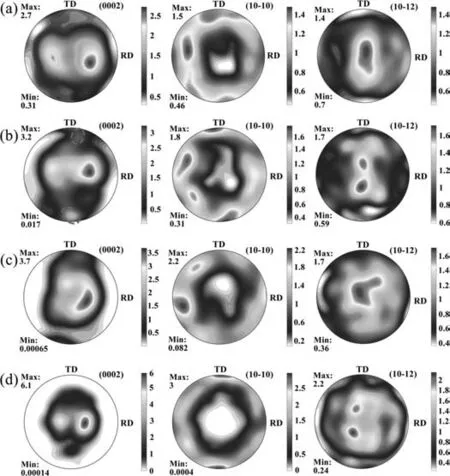
Fig.6.Texture evolution of AZ31 Mg alloy sheet with bimodal non-basal texture during cryogenic rolling: (a) Initial texture;(b) After the first pass;(c) After the second pass;(d) After the fourth pass.
4.Discussion
4.1.Twinning behaviors during cryogenic rolling
Choi et al [24].reported that the twinning activity observed in the rolled pure Ti sheet at cryogenic temperature is significantly higher than that in the rolled pure Ti sheet at room temperature.The main cause they consider about this phenomenon is that the cryogenic temperature contributes to the suppression of dislocation motion during plastic deformation by increasing the critical resolved shear stress (CRSS) of dislocation mode.This issue finally leads to the deteriorated capability to coordinate plastic strain between the neighboring grains,and results in the remarkable local stress concentration near GBs at cryogenic temperature,as compared to room temperature.Similarly,significant local stress would occur within the rolled AZ31 Mg alloy sheet during cryogenic rolling,which would be responsible for the formation of abundant{10–12} ETs in the present study Fig.7.displays the morphology and distribution of these extracted {10–12} ETs as well as the corresponding texture characteristics.The volume fraction of {10–12} ET raises significantly from~8.4% after the first pass of cryogenic rolling to~14.3% after the second pass of cryogenic rolling.Similarly,these rolled samples with initial basal texture also possess an increasing tendency about the volume fraction of {10–12} ET (~2.30% and~2.91%after the first and second pass of cryogenic rolling),as shown in supplementary materials (SFig.3).In addition,the inserted(0002) PF maps in Fig.7 show that the texture evolution caused by these activated {10–12} ETs mainly includes the rotation of the c-axes of grains towards ND and TD during cryogenic rolling.
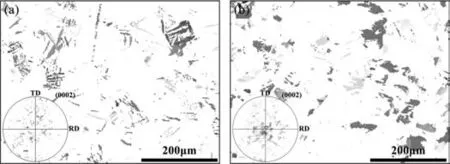
Fig.7.EBSD maps and (0002) PF maps showing the existence of abundant{10–12} ETs in the rolled AZ31 Mg alloy sheets with initial bimodal nonbasal texture after: (a) First pass and (b) Second pass.
OM observations in Fig.3(a–d) and EBSD characterizations in Fig.4 collectively confirm the frequent occurrence of twin-twin interaction among various {10–12} ET variants.It is well known that there exist six variants of {10–12} ET in AZ31 Mg alloy,including (10–12)<-1011>,(01–12)<0–111>,(-1102)<1–101>,(-1012)<10–11>,(0–112)<01–11>and (1–102)<-1101>,and they are often termed as V1 to V6 [20,25,26].The selective activation of various {10–12} ET variants has significant influence on the formation of twin-twin interaction.To further analyze this issue,ten representative grains are selected from the rolled sheet after the first pass of cryogenic rolling,and their IPF maps,(0002) PF maps and twin variants maps are displayed in Fig.8.Twin variant selection in the present study is based on the Schmid factor(SF)analysis,as reported by Hong et al[27].and Wang et al[28].Unlike uniaxial tension/compression,the stress state during rolling can be approximated as the tensile stress along RD and the compressive stress along ND,so the calculation of the theoretical SF values for {10–12} ET variants can be realized via the following equation [29]:
whereφNDandφRDrepresent the angles between the normal direction of twin plane and ND,RD.φNDandφRDrefer to the angles between the twin direction and ND,RD.It is worth noting that due to the polar nature of {10–12} ET,the scope of SFrollingchanges from -0.5 to 0.5 Table 1.displays the theoretical SF values of six {10–12} ET variants for these ten selected grains in Fig.8 and these activated variants are marked in bold Fig.8.clearly demonstrates that for grains 1–3 with their c-axes incline less than 25° towards ND,there only occur one or two {10–12} ET variants,which mainly rotate the initial orientation to TD.When the tilted angle between c-axes of grains and ND increases to 30°–50°,three or four variants in the selected grains 4–7 are activated,which mainly results in the formation of TD-component texture.It is worth noting that all theoretical SF values of six {10–12}ET variants for grains 1–7 are negative in Table 1,indicating that these grains are actually not favorable for the activation of {10–12} ET variants.Therefore,these observed {10–12}ET variants in grains 1–7 could be mainly attributed to the necessity of accommodating the local strain between neighboring grains of Mg alloys during plastic deformation [30].When the tilted angle is larger than 50°,the theoretical SF values become positive and at least five variants are activated in grains 8–10,causing the formation of obvious twin-twin interaction and the rotation of the initial orientation towards TD and ND concurrently during cryogenic rolling.
The aforementioned twinning behaviors with respect to{10–12} ETs are obviously responsible for the concentration of c-axes of grains towards ND and the formation of TDcomponent texture at the beginning of cryogenic rolling on the applied AZ31 Mg alloy sheet with bimodal non-basal texture,as shown in Fig.6(b).However,they fail to explain the disappearance of the TD-component texture during the subsequent cryogenic rolling passes,as shown in Fig.6(c) and (d).Moreover,it is well known that dislocation slip can only lead to the gradual change in texture characteristics for metallic materials during plastic deformation [31].Consequently,there surely exist other twinning behaviors,which could result in this observed sharp texture change.Zhang et al [20].reported that the rare {10–12}-{10–12} DTs,differing from the commonly observed {10–11}-{10–12} DTs in Mg alloys during plastic deformation,can be activated to accommodate plastic strain during the cryogenic rolling process for the casting AZ31 Mg alloy with relatively scattered texture.In fact,a new twin generated inside primary twin is generally called secondary twin relative to primary twin and double twin relative to the parent grain.Therefore,{10–12}-{10–12} DTs mean the occurrence of secondary {10–12} ETs (SETs) in these primary {10–12} ETs (PETs).The formation of these unusual{10–12}-{10–12}DTs originates from the occurrence of stress concentration in local regions and the suppression of these non-basal slips at low temperatures [32,33].In the present study,a careful selection of {10–12}-{10–12} DTs has been further conducted in these rolled sheets after the first pass and the second pass of cryogenic rolling.The corresponding IPF maps inserted with(0002)PF maps are depicted in Fig.9.Obviously,{10–12}-{10–12} DTs rarely occur after the first pass of cryogenic rolling on the applied AZ31 Mg alloy sheet with bimodal non-basal texture and the corresponding volume faction is only about 0.3%.After the second pass of cryogenic rolling,{10–12}-{10–12} DTs occur more frequently and the volume faction sharply increases to 3.5%.Moreover,the occurrence of {10–12}-{10–12} DTs mainly results in the concentration of c-axes of grains around ND.

Fig.9.IPF maps and (0002) PF maps of the selected {10–12}-{10–12} DTs during cryogenic rolling of AZ31 Mg alloy sheets with initial bimodal nonbasal texture after: (a) First pass;(b) Second pass.
To further investigate the twinning behaviors as for {10–12}-{10–12} DTs,two representative grains are carefully selected after the first and second pass of cryogenic rolling,respectively,and the corresponding IPF maps and (0002) PF maps are displayed in Fig.10.The theoretical SF values of six variants of SETs are calculated and shown in Table 2,where the activated variants are marked in bold Fig.10.clearly demonstrates that variants of SETs are more likely to occur in these PETs with c-axes concentrating around TD,while variants of SETs seldom occur in these PETs with caxes concentrating around ND.These calculated SF values in Table 2 further conform this observation that variants of SETs often possess relatively large SF values in PETs with c-axes concentrating around TD by comparison with PETs with c-axes concentrating around ND.

Table 2SF values of six theoretical variants of SETs in selected PETs of grains in Fig.10.
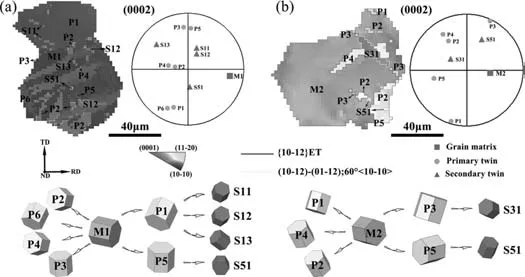
Fig.10.Illustration of high-order sequential twinning in selected grains by using IPF maps,(0002) PF maps and schematic representations based on 3D-orientation in the crystal frame,respectively: (a) Grain M1;(b) Grain M2.
4.2.Involved deformation mechanisms during cryogenic rolling
To quantitatively characterize the evolution of dislocation density during cryogenic rolling of AZ31 Mg alloy sheet with bimodal non-basal texture,the Williamson-Hall(WH)method based on the XRD data is applied in the present study [34].Firstly,the non-deformed Mg powder is used as the standard sample to eliminate the widening caused by the XRD instrument,and the actual widening value is obtained by the following formulation:
whereδhkil,δhkilmandδhkil0represent the actual peak broadening,the full width at half maximum (FWHM) of the tested sample and the standard sample,respectively.Moreover,the relationship between the amount of diffraction peak broadening and micro-strain of rolled sample can be approximately calculated as follows:
where b refers to the Burgers vector (nm).By using the aforementioned WH method,dislocation density in the asreceived sample and these rolled samples are obtained:6.051 × 1013 m-2,1.048 × 1014 m-2,2.862 × 1014 m-2,5.867 × 1014 m-2,and 1.010 × 1015 m-2,respectively(Fig.11(b)).The evolution law of dislocation density agrees well with that of KAM value during cryogenic rolling.As the liquid-nitrogen temperature contributes to suppressing the activities of non-basal slips more severely than that of basalslip during plastic deformation [32,33],basalslip,instead of prismaticslip and pyramidal
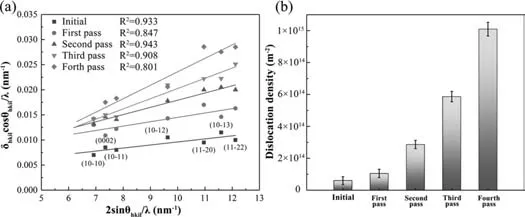
Fig.11.(a)The relationship between δhkiland 2;(b)Evolution of dislocation density during cryogenic rolling.
Finally,an integrated schematic illustration of involved deformation mechanisms during cryogenic rolling of AZ31 Mg alloy sheet with bimodal non-basal texture can be obtained and presented in Fig.12.At the early stage of cryogenic rolling,abundant {10–12} ET variants are activated and served as the main deformation mechanism to accommodate plastic deformation,while the multiplication of dislocation slip is suppressed(Fig.12(a)).Along with the increasing plastic strain,dislocation slips,especially basalslip,begin to largely participate in plastic deformation.Meanwhile,these{10–12} ET variants grow up,then intersect with each other and form numerous (10–12)-(01–12) twin-twin intersections(Fig.12(b)).In the later stage of cryogenic rolling,plenty of dislocation slips are activated and they become the major deformation mechanisms.At the meantime,these PETs with c-axes concentrating around ND continuously enlarge within the matrix grains,while SETs preferentially occur in these PETs with c-axes concentrating around TD,forming the rarely reported {10–12}-{10–12} DTs (Fig.12(c)).These activated {10–12} ETs and {10–12}-{10–12} DTs benefit in sustaining the plastic strain along c-axes of grains and releasing the stress concentration between neighboring grains[20,31].Therefore,the activities of basalslip,{10–12}ETs and {10–12}-{10–12} DTs are identified to be the major cause for the improvement of cryogenic rolling formability in AZ31 Mg alloy sheet with bimodal non-basal texture.
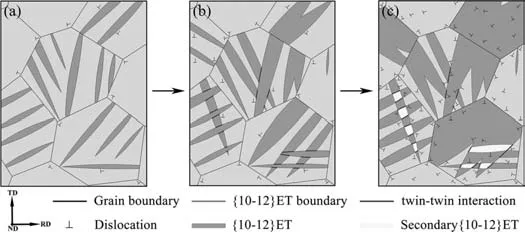
Fig.12.Schematic diagram of involved deformation mechanisms during cryogenic rolling of AZ31 Mg alloy sheet with bimodal non-basal texture.
5.Conclusions
In the present study,cryogenic rolling experiments with the thickness reduction per pass of 5% are conducted on the applied AZ31 Mg alloy sheet with bimodal non-basal texture,which is fabricated by the newly developed ECAR-CBA process.Afterwards,a detailed microstructure characterization on these rolled sheets is performed by using OM,XRD and EBSD measurements.The following conclusions can be obtained.
1.No edge cracks are observed until the fourth pass of cryogenic rolling (the accumulated thickness reduction reaches about 18.5%) in the applied AZ31 Mg alloy sheet with bimodal non-basal texture.The accumulated thickness reduction before the occurrence of edge cracks in AZ31 Mg alloy sheet with typical basal texture is as low as about 9.0% during cryogenic rolling.This obvious enhancement indicates that the bimodal non-basal texture is in favor for the improvement of cryogenic rolling formability
2.The selective activation of {10–12} ET variants depends on the angle between c-axes of grains and ND of the sheet.The as-received sheet possesses a bimodal non-basal texture with the basal poles tilt about ±40° away from ND to RD.This texture would result in the activation of at least three {10–12} ET variants during cryogenic rolling.This issue further leads to the formation of twin-twin interaction among various {10–12} ET variants.The twinning behaviors as for {10–12} ETs are responsible for the concentration of c-axes of grains towards ND and the formation of TD-component texture at the beginning of cryogenic rolling.
3.At the later stage of cryogenic rolling,SETs preferentially occur in these PETs with c-axes concentrating around TD,forming these rarely reported {10–12}-{10–12} DTs.Meanwhile,the corresponding volume faction increases quickly with the increasing rolling passes to sustain plastic strain.The twinning behaviors with respect to {10–12}-{10–12} DTs are responsible for the disappearance of TD-component texture.
4.The evolution of involved deformation mechanisms can be summarized as follows: numerous {10–12} ETs+a small amount of dislocation slips → enlarged {10–12} ETs+twin-twin interaction among {10–12}ETs+increasing dislocation slips →enlarged {10–12}ETs+twin-twin interaction among {10–12} ETs+the occurrence of {10–12}-{10–12} DTs+extensive dislocation slips.These twinning behaviors and the activity of basalslip contribute to the improved rolling formability in AZ31 Mg alloy sheet with bimodal non-basal texture during cryogenic rolling.
Declarations of competing interest
None.
Acknowledgments
This work was supported by the National Natural Science Foundation of China (Grant Nos.51805064,51822509),the Qingnian project of science and technology research program of Chongqing Education Commission of China (Grant No.KJQN202101141).
Supplementary materials
Supplementary material associated with this article can be found,in the online version,at doi:10.1016/j.jma.2022.01.011.
 Journal of Magnesium and Alloys2023年7期
Journal of Magnesium and Alloys2023年7期
- Journal of Magnesium and Alloys的其它文章
- Recent progress in MgB2 superconducting joint technology
- “Smart” micro/nano container-based self-healing coatings on magnesium alloys: A review
- Recent advances using equal-channel angular pressing to improve the properties of biodegradable Mg–Zn alloys
- Twin evolution in cast Mg-Gd-Y alloys and its dependence on aging heat treatment
- Effects of Ce content on the modification of Mg2Si phase in Mg-5Al-2Si alloy
- Solute drag-controlled grain growth in magnesium investigated by quasi in-situ orientation mapping and level-set simulations
